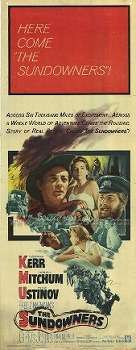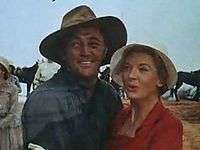The Sundowners (1960 film)
| The Sundowners | |
|---|---|
 film poster | |
| Directed by | Fred Zinnemann |
| Produced by |
Gerry Blattner Fred Zinnemann |
| Screenplay by | Isobel Lennart |
| Based on |
The Sundowners by Jon Cleary |
| Starring |
Deborah Kerr Robert Mitchum Peter Ustinov |
| Music by | Dimitri Tiomkin |
| Cinematography | Jack Hildyard |
| Edited by | Jack Harris |
| Distributed by | Warner Bros. |
Release date |
|
Running time | 141 min.[1][2] |
| Country |
United States United Kingdom Australia[1][3] |
| Language | English |
| Box office | $3.8 million |
The Sundowners is a 1960 Technicolor film that tells the story of an Australian outback family torn between the father's desires to continue his nomadic sheep-herding ways and the wife's and son's desire to settle down in one place. The film stars Deborah Kerr, Robert Mitchum, and Peter Ustinov, with a supporting cast including Glynis Johns, Dina Merrill, Michael Anderson Jr., and Chips Rafferty.
The screenplay was adapted by Isobel Lennart from Jon Cleary's novel of the same name; it was produced and directed by Fred Zinnemann.[2]
At the 33rd Academy Awards, The Sundowners was nominated for Best Actress in a Leading Role (Deborah Kerr), Best Actress in a Supporting Role (Glynis Johns), Best Director, Best Picture, and Best Writing, Screenplay Based on Material from Another Medium.
Plot
Irish-Australian Paddy Carmody (Robert Mitchum) is a sheep drover and shearer, roving the sparsely populated back country with his wife Ida (Deborah Kerr) and son Sean (Michael Anderson Jr.).[2] They are sundowners, constantly moving, pitching their tent whenever the sun goes down. Ida and Sean want to settle down, but Paddy has wanderlust and never wants to stay in one place for long. While passing through the bush, the family meet refined Englishman Rupert Venneker (Peter Ustinov) and hire him to help drive a large herd of sheep to the town of Cawndilla. Along the way, they survive a dangerous brush fire.
Mrs. Firth (Glynis Johns), who runs the pub in Cawndilla, takes a liking to Rupert. He takes to spending nights with her, but, like Paddy, he has no desire to be tied down.
Ida convinces Paddy to take a job at a station shearing sheep; she serves as the cook, Rupert as a wool roller, and Sean as a tar boy. Ida enjoys the company of another woman, their employer's lonely wife, Jean Halstead (Dina Merrill). When fellow shearer Bluey Brown's (John Meillon) pregnant wife Liz (Lola Brooks) shows up unannounced, she sees the young woman through her first birth.
Ida is saving the money the family earns for a farm that they stayed at for a night on the sheep drive. Even though Paddy has agreed to participate in a shearing contest against someone from a rival group, he decides to leave six weeks into the shearing season. Ida persuades him to stay. He loses the contest to an old veteran.
Paddy wins a lot of money and a race horse playing two-up. Owning such an animal has been his longstanding dream. They name him Sundowner and enter him, with Sean as his jockey, at local races on their travels after the shearing is done. Sean and Sundowner win their first race.
Ida finally convinces a still reluctant Paddy to buy the farm she and Sean have their hearts set on. However, he loses everything Ida has saved for the down payment in a single night of playing two-up. By way of apology, he tells her that he has found a buyer for Sundowner if he wins the next race. The money would recoup their down payment. Though Sundowner does win, he is disqualified for interference and the deal falls through. Nevertheless, Paddy's deep remorse heals the breach with Ida, and they resolve to save enough money to buy a farm one day.
Cast



- Deborah Kerr as Ida Carmody
- Robert Mitchum as Paddy Carmody
- Peter Ustinov as Rupert Venneker
- Glynis Johns as Mrs. Firth
- Dina Merrill as Jean Halstead
- Chips Rafferty as Quinlan
- Michael Anderson Jr. as Sean Carmody
- Wylie Watson as Herb Johnson
- John Meillon as Bluey Brown
- Ronald Fraser as Ocker
- Gerry Duggan as Shearer
- Leonard Teale as Shearer
- Dick Bentley as Shearer
Production
Fred Zinnemann decided to make the film at the suggestion of Dorothy Hammerstein, Australian-born second wife of Oscar Hammerstein II.[1] She intended to send him a copy of the novel The Shiralee (later filmed with Peter Finch), but accidentally sent a copy of The Sundowners instead. He immediately bought the screen rights and decided to produce it himself.[4] According to Zinnemann's autography, Aaron Spelling was originally signed to write the screenplay, but was replaced by Isobel Lennart;[1] another source says the screenplay was mostly written by Jon Cleary, in spite of Lennart's screen credit.[5] The ending of the film was a tribute to John Huston's The Treasure of the Sierra Madre.[6] Gary Cooper was hired to play Paddy Carmody, but had to leave due to poor health. He was replaced by Robert Mitchum, who agreed to work on the film for a chance to appear opposite Deborah Kerr, with whom he had become good friends while making Heaven Knows, Mr. Allison together. He also agreed to give her top billing, joking to the production team that they could "design a twenty-four-foot sign of me bowing to her if you like".[7] Michael Anderson, Jr. was imported from England to play their son.[8]
Zinnemann was determined to film The Sundowners on location and vetoed Jack L. Warner's plan to shoot in Arizona or near Dallas, Texas, to save money. Interiors were shot at Associated British Pictures Corp. Elstree Studios in England;[1][9] exteriors were shot in Australia at Cooma, Nimmitabel, and Jindabyne of New South Wales and in Port Augusta, Whyalla, Quorn, Iron Knob, Hawker and Carriewerloo in South Australia.[1][7] The "for-sale" property in the film was actually called "Hiawatha" and was on the Snowy River just north of Old Jindabyne (now under the waters of Lake Jindabyne).[10]
Filming began in 1959.[11] Zinnemann spent 12 weeks filming scenery and sheep herding before the cast arrived in October. The weather made location filming difficult, fluctuating from hot and humid to cold and rainy. This delayed production by several weeks and caused some irritation among the cast and crew. Mitchum was often harassed by fans and eventually moved onto a boat to avoid them. Filming wrapped on 17 December 1959.[7] A number of Australian actors appeared in the supporting cast.[12]
Ray Austin was the stunt coordinator. Nicolas Roeg, who would later direct films such as Walkabout, was a second unit camera operator.[13]
Reception
Bosley Crowther called the film an "especially appropriate entertainment for the Christmas holidays"; according to Crowther:[2]
What is nice about these people and valid about this film, is that they have an abundance of freshness, openness and vitality. The action scenes are dynamic—the scenes of driving sheep, shearing them, racing horses at a genuine 'bush country' track and simply living happily in the great sky-covered outdoors. And the scenes of human involvements—those between the husband and the wife, of a woman having a baby, of a footloose housewife looking at a stove—are deeply and poignantly revealing of how good and sensitive people can be.
The Sundowners, marketed as a "newer version" of From Here to Eternity, was a financial failure in the United States.[7] The film reached the top ten at the UK box office and was the third highest grossing film of 1961 in Australia.[14]
Awards
33rd Academy Awards
- Nomination for Best Film
- Nomination for Best Performance by an Actress – Deborah Kerr
- Nomination for Best Performance by an Actress in a Supporting Role – Glynis Johns
- Nomination for Best Achievement in Directing – Fred Zinneman
- Nomination for Best Screenplay Based on Material from Another Medium – Isobel Lennart[14]
Other awards and honours
- New York Film Critics Circle Award for Best Actress – Deborah Kerr
- National Board of Review Award for Best Actor – Robert Mitchum (also for Home from the Hill)
- Named Third Best Film of 1960 by the National Board of Review of Motion Pictures
- Named Fourth Best Film of 1960 by the New York Daily News
- Named one of the Ten Best Films of 1960 by The New York Post, The Saturday Review and the New York World-Telegram[14]
References
- 1 2 3 4 5 6 7 The Sundowners at the TCM Movie Database (including notes and other AFI catalog data). Retrieved 15 April 2013.
- 1 2 3 4 Crowther, Bosley (9 December 1960). "Film on Australians Opens at Music Hall". The New York Times. Retrieved 15 April 2013.
What is nice about these people and valid about this film, is that they have an abundance of freshness, openness and vitality. The action scenes are dynamic—the scenes of driving sheep, shearing them, racing horses at a genuine "bush country" track and simply living happily in the great sky-covered outdoors. And the scenes of human involvements—those between the husband and the wife, of a woman having a baby, of a footloose housewife looking at a stove—are deeply and poignantly revealing of how good and sensitive people can be. The Sundowners—that's what the Australians call a migrant, a wanderer without a home—is an especially appropriate entertainment for the Christmas holidays.
- ↑ The Sundowners at AllMovie
- ↑ "THE WEEKLY ROUND". The Australian Women's Weekly. National Library of Australia. 29 January 1958. p. 2. Retrieved 28 February 2012.
- ↑ Sinyard, Neil (2003). Fred Zinnemann: films of character and conscience. McFarland. pp. 116–121. ISBN 978-0-7864-1711-7.
- ↑ Nolletti, Arthur (1999). The films of Fred Zinnemann: critical perspectives. SUNY Press. p. 33. ISBN 978-0-7914-4225-8.
- 1 2 3 4 Capua, Michelangelo (2010). Deborah Kerr: A Biography. McFarland. pp. 123–28. ISBN 978-0-7864-5882-0.
- ↑ "Children of 'The Sundowners'". The Australian Women's Weekly. National Library of Australia. 7 October 1959. p. 5. Retrieved 28 February 2012.
- ↑ Phillips, Gene D. (1998). Exiles in Hollywood: major European film directors in America. Lehigh University Press. pp. 160–2. ISBN 0-934223-49-1.
- ↑ "George Wallace". Monaro Pioneers. Retrieved 2018-08-20.
In late 1959 "Hiawatha" homestead was used by Warner Brothers in the filming of "The Sundowners" Unfortunately Fred did not live to see the picture when it came to Australia as with failing health and the threat of the Snowy Mountains hydro-electric scheme resuming his property, he passed away in 1961 being the first to be buried in the New Jindabyne Cemetery. The property was later to be resumed by the S.M.H.E.A. and is now under the waters of Lake Jindabyne.
- ↑ "BIG STARS FOR 'SUNDOWNERS'". The Australian Women's Weekly. National Library of Australia. 13 May 1959. p. 9. Retrieved 28 February 2012.
- ↑ "A team of Sundowners". The Australian Women's Weekly. National Library of Australia. 14 October 1959. p. 5. Retrieved 28 February 2012.
- ↑ Nowra, Louis (2003). Walkabout. Currency Press. p. 77. ISBN 0-86819-700-9.
- 1 2 3 Reid, John Howard (2006). America's Best, Britain's Finest: A Survey of Mixed Movies. Lulu. p. 236. ISBN 978-1-4116-7877-4.
External links
| Wikimedia Commons has media related to The Sundowners (1960 film). |
- The Sundowners at the American Film Institute Catalog
- The Sundowners on IMDb
- The Sundowners at Rotten Tomatoes
- The Sundowners at AllMovie
- The Sundowners at the TCM Movie Database
- The Sundowners at Australian Screen Online
- The Sundowners at Oz Movies